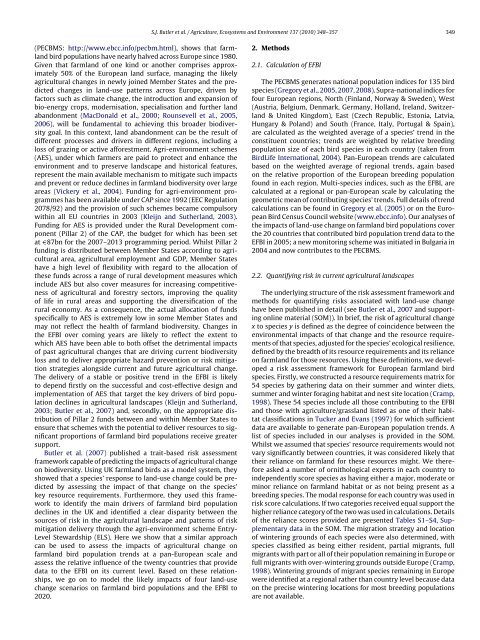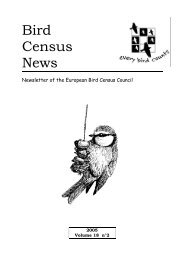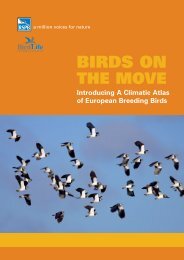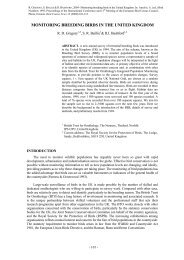Quantifying the impact of land-use change to European farmland ...
Quantifying the impact of land-use change to European farmland ...
Quantifying the impact of land-use change to European farmland ...
Create successful ePaper yourself
Turn your PDF publications into a flip-book with our unique Google optimized e-Paper software.
(PECBMS: http://www.ebcc.info/pecbm.html), shows that farm<strong>land</strong><br />
bird populations have nearly halved across Europe since 1980.<br />
Given that farm<strong>land</strong> <strong>of</strong> one kind or ano<strong>the</strong>r comprises approximately<br />
50% <strong>of</strong> <strong>the</strong> <strong>European</strong> <strong>land</strong> surface, managing <strong>the</strong> likely<br />
agricultural <strong>change</strong>s in newly joined Member States and <strong>the</strong> predicted<br />
<strong>change</strong>s in <strong>land</strong>-<strong>use</strong> patterns across Europe, driven by<br />
fac<strong>to</strong>rs such as climate <strong>change</strong>, <strong>the</strong> introduction and expansion <strong>of</strong><br />
bio-energy crops, modernisation, specialisation and fur<strong>the</strong>r <strong>land</strong><br />
abandonment (MacDonald et al., 2000; Rounsevell et al., 2005,<br />
2006), will be fundamental <strong>to</strong> achieving this broader biodiversity<br />
goal. In this context, <strong>land</strong> abandonment can be <strong>the</strong> result <strong>of</strong><br />
different processes and drivers in different regions, including a<br />
loss <strong>of</strong> grazing or active afforestment. Agri-environment schemes<br />
(AES), under which farmers are paid <strong>to</strong> protect and enhance <strong>the</strong><br />
environment and <strong>to</strong> preserve <strong>land</strong>scape and his<strong>to</strong>rical features,<br />
represent <strong>the</strong> main available mechanism <strong>to</strong> mitigate such <strong>impact</strong>s<br />
and prevent or reduce declines in farm<strong>land</strong> biodiversity over large<br />
areas (Vickery et al., 2004). Funding for agri-environment programmes<br />
has been available under CAP since 1992 (EEC Regulation<br />
2078/92) and <strong>the</strong> provision <strong>of</strong> such schemes became compulsory<br />
within all EU countries in 2003 (Kleijn and Su<strong>the</strong>r<strong>land</strong>, 2003).<br />
Funding for AES is provided under <strong>the</strong> Rural Development component<br />
(Pillar 2) <strong>of</strong> <strong>the</strong> CAP, <strong>the</strong> budget for which has been set<br />
at D 87bn for <strong>the</strong> 2007–2013 programming period. Whilst Pillar 2<br />
funding is distributed between Member States according <strong>to</strong> agricultural<br />
area, agricultural employment and GDP, Member States<br />
have a high level <strong>of</strong> flexibility with regard <strong>to</strong> <strong>the</strong> allocation <strong>of</strong><br />
<strong>the</strong>se funds across a range <strong>of</strong> rural development measures which<br />
include AES but also cover measures for increasing competitiveness<br />
<strong>of</strong> agricultural and forestry sec<strong>to</strong>rs, improving <strong>the</strong> quality<br />
<strong>of</strong> life in rural areas and supporting <strong>the</strong> diversification <strong>of</strong> <strong>the</strong><br />
rural economy. As a consequence, <strong>the</strong> actual allocation <strong>of</strong> funds<br />
specifically <strong>to</strong> AES is extremely low in some Member States and<br />
may not reflect <strong>the</strong> health <strong>of</strong> farm<strong>land</strong> biodiversity. Changes in<br />
<strong>the</strong> EFBI over coming years are likely <strong>to</strong> reflect <strong>the</strong> extent <strong>to</strong><br />
which AES have been able <strong>to</strong> both <strong>of</strong>fset <strong>the</strong> detrimental <strong>impact</strong>s<br />
<strong>of</strong> past agricultural <strong>change</strong>s that are driving current biodiversity<br />
loss and <strong>to</strong> deliver appropriate hazard prevention or risk mitigation<br />
strategies alongside current and future agricultural <strong>change</strong>.<br />
The delivery <strong>of</strong> a stable or positive trend in <strong>the</strong> EFBI is likely<br />
<strong>to</strong> depend firstly on <strong>the</strong> successful and cost-effective design and<br />
implementation <strong>of</strong> AES that target <strong>the</strong> key drivers <strong>of</strong> bird population<br />
declines in agricultural <strong>land</strong>scapes (Kleijn and Su<strong>the</strong>r<strong>land</strong>,<br />
2003; Butler et al., 2007) and, secondly, on <strong>the</strong> appropriate distribution<br />
<strong>of</strong> Pillar 2 funds between and within Member States <strong>to</strong><br />
ensure that schemes with <strong>the</strong> potential <strong>to</strong> deliver resources <strong>to</strong> significant<br />
proportions <strong>of</strong> farm<strong>land</strong> bird populations receive greater<br />
support.<br />
Butler et al. (2007) published a trait-based risk assessment<br />
framework capable <strong>of</strong> predicting <strong>the</strong> <strong>impact</strong>s <strong>of</strong> agricultural <strong>change</strong><br />
on biodiversity. Using UK farm<strong>land</strong> birds as a model system, <strong>the</strong>y<br />
showed that a species’ response <strong>to</strong> <strong>land</strong>-<strong>use</strong> <strong>change</strong> could be predicted<br />
by assessing <strong>the</strong> <strong>impact</strong> <strong>of</strong> that <strong>change</strong> on <strong>the</strong> species’<br />
key resource requirements. Fur<strong>the</strong>rmore, <strong>the</strong>y <strong>use</strong>d this framework<br />
<strong>to</strong> identify <strong>the</strong> main drivers <strong>of</strong> farm<strong>land</strong> bird population<br />
declines in <strong>the</strong> UK and identified a clear disparity between <strong>the</strong><br />
sources <strong>of</strong> risk in <strong>the</strong> agricultural <strong>land</strong>scape and patterns <strong>of</strong> risk<br />
mitigation delivery through <strong>the</strong> agri-environment scheme Entry-<br />
Level Stewardship (ELS). Here we show that a similar approach<br />
can be <strong>use</strong>d <strong>to</strong> assess <strong>the</strong> <strong>impact</strong>s <strong>of</strong> agricultural <strong>change</strong> on<br />
farm<strong>land</strong> bird population trends at a pan-<strong>European</strong> scale and<br />
assess <strong>the</strong> relative influence <strong>of</strong> <strong>the</strong> twenty countries that provide<br />
data <strong>to</strong> <strong>the</strong> EFBI on its current level. Based on <strong>the</strong>se relationships,<br />
we go on <strong>to</strong> model <strong>the</strong> likely <strong>impact</strong>s <strong>of</strong> four <strong>land</strong>-<strong>use</strong><br />
<strong>change</strong> scenarios on farm<strong>land</strong> bird populations and <strong>the</strong> EFBI <strong>to</strong><br />
2020.<br />
S.J. Butler et al. / Agriculture, Ecosystems and Environment 137 (2010) 348–357 349<br />
2. Methods<br />
2.1. Calculation <strong>of</strong> EFBI<br />
The PECBMS generates national population indices for 135 bird<br />
species (Gregory et al., 2005, 2007, 2008). Supra-national indices for<br />
four <strong>European</strong> regions, North (Fin<strong>land</strong>, Norway & Sweden), West<br />
(Austria, Belgium, Denmark, Germany, Hol<strong>land</strong>, Ire<strong>land</strong>, Switzer<strong>land</strong><br />
& United Kingdom), East (Czech Republic, Es<strong>to</strong>nia, Latvia,<br />
Hungary & Po<strong>land</strong>) and South (France, Italy, Portugal & Spain),<br />
are calculated as <strong>the</strong> weighted average <strong>of</strong> a species’ trend in <strong>the</strong><br />
constituent countries; trends are weighted by relative breeding<br />
population size <strong>of</strong> each bird species in each country (taken from<br />
BirdLife International, 2004). Pan-<strong>European</strong> trends are calculated<br />
based on <strong>the</strong> weighted average <strong>of</strong> regional trends, again based<br />
on <strong>the</strong> relative proportion <strong>of</strong> <strong>the</strong> <strong>European</strong> breeding population<br />
found in each region. Multi-species indices, such as <strong>the</strong> EFBI, are<br />
calculated at a regional or pan-<strong>European</strong> scale by calculating <strong>the</strong><br />
geometric mean <strong>of</strong> contributing species’ trends. Full details <strong>of</strong> trend<br />
calculations can be found in Gregory et al. (2005) or on <strong>the</strong> <strong>European</strong><br />
Bird Census Council website (www.ebcc.info). Our analyses <strong>of</strong><br />
<strong>the</strong> <strong>impact</strong>s <strong>of</strong> <strong>land</strong>-<strong>use</strong> <strong>change</strong> on farm<strong>land</strong> bird populations cover<br />
<strong>the</strong> 20 countries that contributed bird population trend data <strong>to</strong> <strong>the</strong><br />
EFBI in 2005; a new moni<strong>to</strong>ring scheme was initiated in Bulgaria in<br />
2004 and now contributes <strong>to</strong> <strong>the</strong> PECBMS.<br />
2.2. <strong>Quantifying</strong> risk in current agricultural <strong>land</strong>scapes<br />
The underlying structure <strong>of</strong> <strong>the</strong> risk assessment framework and<br />
methods for quantifying risks associated with <strong>land</strong>-<strong>use</strong> <strong>change</strong><br />
have been published in detail (see Butler et al., 2007 and supporting<br />
online material (SOM)). In brief, <strong>the</strong> risk <strong>of</strong> agricultural <strong>change</strong><br />
x <strong>to</strong> species y is defined as <strong>the</strong> degree <strong>of</strong> coincidence between <strong>the</strong><br />
environmental <strong>impact</strong>s <strong>of</strong> that <strong>change</strong> and <strong>the</strong> resource requirements<br />
<strong>of</strong> that species, adjusted for <strong>the</strong> species’ ecological resilience,<br />
defined by <strong>the</strong> breadth <strong>of</strong> its resource requirements and its reliance<br />
on farm<strong>land</strong> for those resources. Using <strong>the</strong>se definitions, we developed<br />
a risk assessment framework for <strong>European</strong> farm<strong>land</strong> bird<br />
species. Firstly, we constructed a resource requirements matrix for<br />
54 species by ga<strong>the</strong>ring data on <strong>the</strong>ir summer and winter diets,<br />
summer and winter foraging habitat and nest site location (Cramp,<br />
1998). These 54 species include all those contributing <strong>to</strong> <strong>the</strong> EFBI<br />
and those with agriculture/grass<strong>land</strong> listed as one <strong>of</strong> <strong>the</strong>ir habitat<br />
classifications in Tucker and Evans (1997) for which sufficient<br />
data are available <strong>to</strong> generate pan-<strong>European</strong> population trends. A<br />
list <strong>of</strong> species included in our analyses is provided in <strong>the</strong> SOM.<br />
Whilst we assumed that species’ resource requirements would not<br />
vary significantly between countries, it was considered likely that<br />
<strong>the</strong>ir reliance on farm<strong>land</strong> for <strong>the</strong>se resources might. We <strong>the</strong>refore<br />
asked a number <strong>of</strong> ornithological experts in each country <strong>to</strong><br />
independently score species as having ei<strong>the</strong>r a major, moderate or<br />
minor reliance on farm<strong>land</strong> habitat or as not being present as a<br />
breeding species. The modal response for each country was <strong>use</strong>d in<br />
risk score calculations. If two categories received equal support <strong>the</strong><br />
higher reliance category <strong>of</strong> <strong>the</strong> two was <strong>use</strong>d in calculations. Details<br />
<strong>of</strong> <strong>the</strong> reliance scores provided are presented Tables S1–S4, Supplementary<br />
data in <strong>the</strong> SOM. The migration strategy and location<br />
<strong>of</strong> wintering grounds <strong>of</strong> each species were also determined, with<br />
species classified as being ei<strong>the</strong>r resident, partial migrants, full<br />
migrants with part or all <strong>of</strong> <strong>the</strong>ir population remaining in Europe or<br />
full migrants with over-wintering grounds outside Europe (Cramp,<br />
1998). Wintering grounds <strong>of</strong> migrant species remaining in Europe<br />
were identified at a regional ra<strong>the</strong>r than country level beca<strong>use</strong> data<br />
on <strong>the</strong> precise wintering locations for most breeding populations<br />
are not available.






